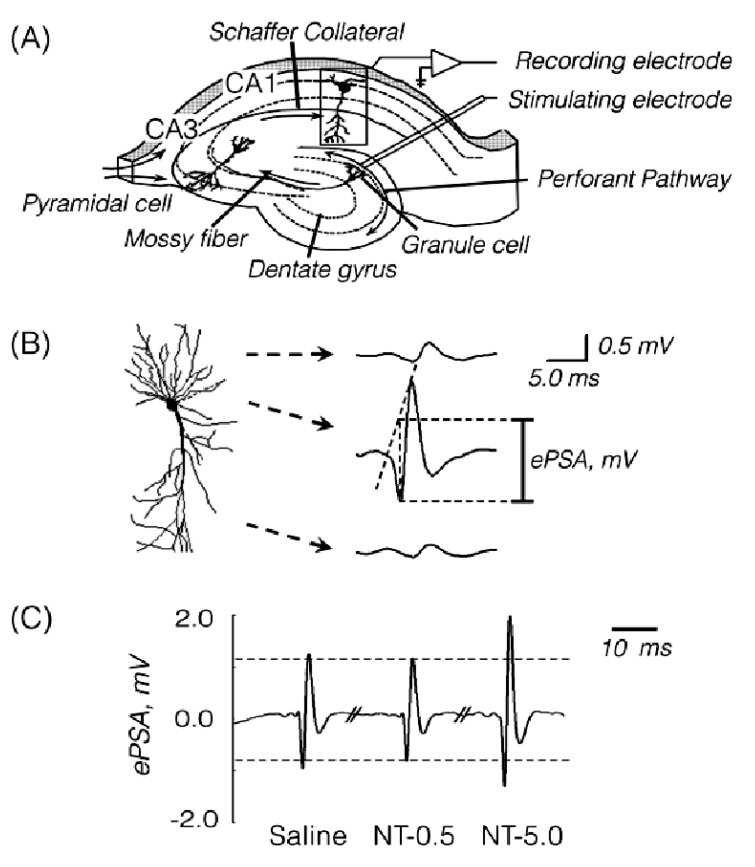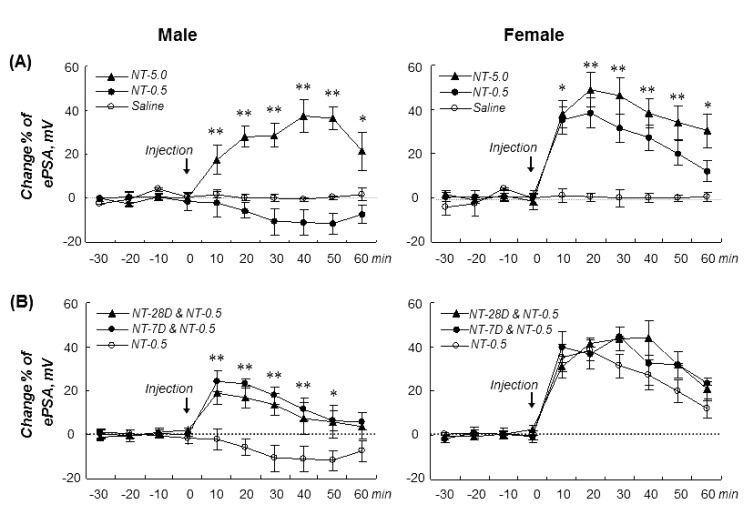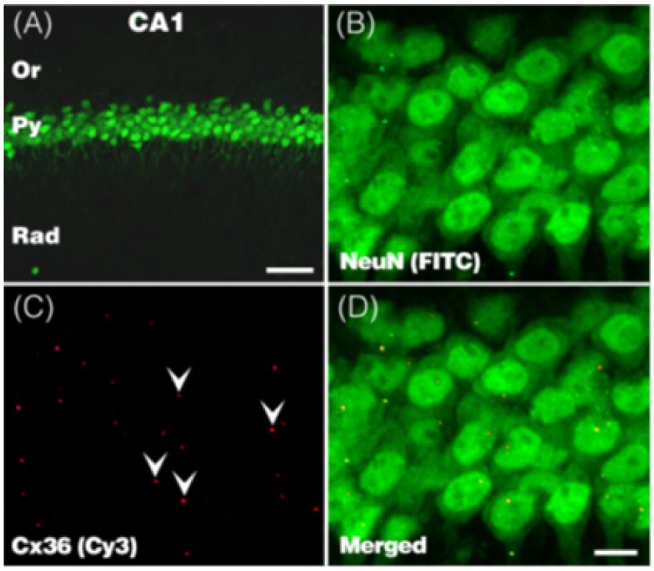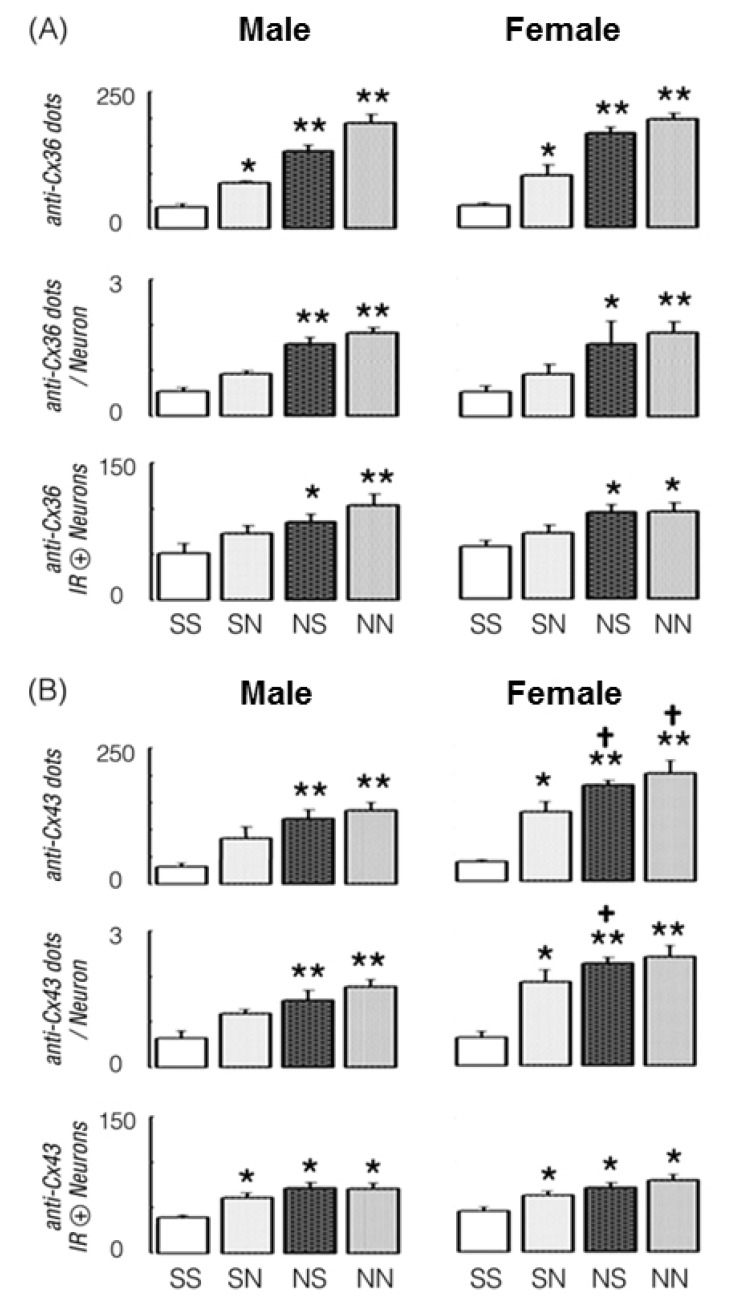Korean J Physiol Pharmacol.
2013 Oct;17(5):405-409. 10.4196/kjpp.2013.17.5.405.
Sex Differences in Hippocampal Neuronal Sensitization by Nicotine in M. gerbils
- Affiliations
-
- 1Department of Pharmacology, Korea University College of Medicine, Seoul 136-705, Korea. bgchun@korea.ac.kr
- 2Department of Anatomy, College of Veterinary Medicine, Gyeongsang National University, Jinju 660-701, Korea.
- KMID: 1500234
- DOI: http://doi.org/10.4196/kjpp.2013.17.5.405
Abstract
- We studied the sex different nicotine effect on evoked population spike amplitudes (ePSA) and connexin (Cx) expression in the hippocampus CA1 area of gerbils. Acute doses of nicotine bitartrate (0.5 mg/kg: NT-0.5) slightly reduced ePSA in males but markedly augmented that in females. Acute NT (5.0 mg/kg) markedly increased the ePSA in all gerbils. Unlike acute NT-0.5, repeated NT-0.5 injection (twice a day for 7 days) significantly increased the ePSA in males and slightly affected the NT-0.5 effect in females. The Cx36 and Cx43 expression levels as well as Cx expressing neuronal populations were significantly increased by repeated NT-0.5 in in both male and female gerbils, and particularly, Cx43 expression was somewhat prominent in females. These results demonstrated a sex difference with respect to the nicotine effect on hippocampal bisynaptic excitability, irrelevant to connexin expression.
Keyword
MeSH Terms
Figure
Reference
-
1. Dani JA, Ji D, Zhou FM. Synaptic plasticity and nicotine addiction. Neuron. 2001; 31:349–352. PMID: 11516393.
Article2. Shim I, Javaid JI, Wirtshafter D, Jang SY, Shin KH, Lee HJ, Chung YC, Chun BG. Nicotine-induced behavioral sensitization is associated with extracellular dopamine release and expression of c-Fos in the striatum and nucleus accumbens of the rat. Behav Brain Res. 2001; 121:137–147. PMID: 11275291.
Article3. Gray R, Rajan AS, Radcliffe KA, Yakehiro M, Dani JA. Hippocampal synaptic transmission enhanced by low concentrations of nicotine. Nature. 1996; 383:713–716. PMID: 8878480.
Article4. Freund RK, Luntz-Leybman V, Collins AC. Nicotine interferes with GABA-mediated inhibitory processes in mouse hippocampus. Brain Res. 1990; 527:286–291. PMID: 2253036.
Article5. Traub RD, Pais I, Bibbig A, LeBeau FE, Buhl EH, Hormuzdi SG, Monyer H, Whittington MA. Contrasting roles of axonal (pyramidal cell) and dendritic (interneuron) electrical coupling in the generation of neuronal network oscillations. Proc Natl Acad Sci U S A. 2003; 100:1370–1374. PMID: 12525690.
Article6. McCracken CB, Roberts DCS. Neuronal gap junctions: expression, function, and implications for behavior. Int Rev Neurobiol. 2006; 73:125–151. PMID: 16737903.
Article7. Colomer C, Olivos Ore LA, Coutry N, Mathieu MN, Arthaud S, Fontanaud P, Iankova I, Macari F, Thouënnon E, Yon L, Anouar Y, Guérineau NC. Functional remodeling of gap junction-mediated electrical communication between adrenal chromaffin cells in stressed rats. J Neurosci. 2008; 28:6616–6626. PMID: 18579734.
Article8. Tsai CH, Yeh HI, Tian TY, Lee YN, Lu CS, Ko YS. Down-regulating effect of nicotine on connexin43 gap junctions in human umbilical vein endothelial cells is attenuated by statins. Eur J Cell Biol. 2004; 82:589–595. PMID: 15035434.
Article9. Zhang TA, Tang J, Pidoplichko VI, Dani JA. Addictive nicotine alters local circuit inhibition during the induction of in vivo hippocampal synaptic potentiation. J Neurosci. 2010; 30:6443–6645. PMID: 20445070.10. Rash JE, Yasumura T, Dudek FE, Nagy JI. Cell-specific expression of connexins and evidence of restricted gap junctional coupling between glial cells and between neurons. J Neurosci. 2001; 21:1983–2000. PMID: 11245683.
Article11. Urban L, Neill KH, Crain BJ, Nadler JV, Somjen GG. Postischemic synaptic physiology in area CA1 of the gerbil hippocampus studied in vitro. J Neurosci. 1989; 9:3966–3975. PMID: 2585062.12. Gill R, Kemp JA. Protection of CA1 pyramidal cell function by MK-801 following ischaemia in the gerbil. Neurosci Lett. 1989; 105:101–106. PMID: 2484724.
Article13. Yun SH, Park KA, Kwon S, Woolley CS, Sullivan PM, Pasternak JF, Trommer BL. Estradiol enhances long term potentiation in hippocampal slices from aged apoE4-TR mice. Hippocampus. 2007; 17:1153–1157. PMID: 17696167.
Article14. Smith CC, McMahon LL. Estradiol-induced increase in the magnitude of long-term potentiation is prevented by blocking NR2B-containing receptors. J Neurosci. 2006; 26:8517–8522. PMID: 16914677.
Article15. Perez J, Tranque PA, Naftolin F, Garcia-Segura LM. Gap junctions in the hypothalamic arcuate neurons of ovariectomized and estradiol-treated rats. Neurosci Lett. 1990; 108:17–21. PMID: 2304626.
Article16. Leranth C, Hajszan T, MacLusky NJ. Androgens increase spine synapse density in the CA1 hippocampal subfield of ovariectomized female rats. J Neurosci. 2004; 24:495–499. PMID: 14724248.
Article17. Leranth C, Petnehazy O, MacLusky NJ. Gonadal hormones affect spine synaptic density in the CA1 hippocampal subfield of male rats. J Neurosci. 2003; 23:1588–1592. PMID: 12629162.
Article18. Matsumoto A, Arnold AP, Zamphigi GA, Micevych PE. Androgenic regulation of gap junction between motoneurons in the rat spinal cord. J Neurosci. 1988; 8:4177–4183. PMID: 3183718.19. Matsuyama S, Matsumoto A, Enomoto T, Nishizaki T. Activation of nicotinic acetylcholine receptors induces long-term potentiation in vivo in the intact mouse dentate gyrus. Eur J Neurosci. 2000; 12:3741–3747. PMID: 11029644.20. Harley CE, Malsbury CW, Squires A, Brown RAM. Testosterone decreases CA1 plasticity in vivo in gonadectomized male rats. Hippocampus. 2000; 10:693–697. PMID: 11153715.
Article
- Full Text Links
- Actions
-
Cited
- CITED
-
- Close
- Share
- Similar articles
-
- Effect of sedative dose of propofol on neuronal damage after transient forebrain ischemia in Mongolian gerbils
- Transient forebrain ischemia induces impairment in cognitive performance prior to extensive neuronal cell death in Mongolian gerbil (Meriones unguiculatus)
- The effects of peripheral leukocytes on the hippocampal neuronal changes in transient global ischemia and unilateral cerebral hemispheric infarction
- Effect of systemic temperature on hippocampal neuronal survival in transient global ischemia animal model
- Morphological Analysis of Short and Long Term Changes after Ligation of Unilateral Common Carotid Artery in Gerbils





